
Gracilaria is a genus of red algae (Rhodophyta) notable for its economic importance as an agarophyte, as well as its use as a food for humans and various species of shellfish. Various species in the genus are cultivated among Asia, South America, Africa and Oceania.

Ceramium is a genus of Ceramium algae. It is a large genus with at least 15 species in the British Isles.

Red algae, or Rhodophyta, are one of the oldest groups of eukaryotic algae. The Rhodophyta comprises one of the largest phyla of algae, containing over 7,000 currently recognized species with taxonomic revisions ongoing. The majority of species (6,793) are found in the Florideophyceae (class), and mostly consist of multicellular, marine algae, including many notable seaweeds. Red algae are abundant in marine habitats but relatively rare in freshwaters. Approximately 5% of red algae species occur in freshwater environments, with greater concentrations found in warmer areas. Except for two coastal cave dwelling species in the asexual class Cyanidiophyceae, there are no terrestrial species, which may be due to an evolutionary bottleneck in which the last common ancestor lost about 25% of its core genes and much of its evolutionary plasticity.
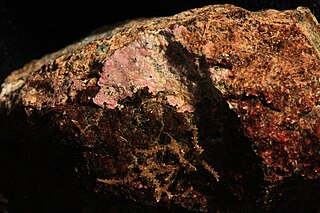
Hildenbrandia is a genus of thalloid red alga comprising about 26 species. The slow-growing, non-mineralized thalli take a crustose form. Hildenbrandia reproduces by means of conceptacles and produces tetraspores.

Claudea is a marine red alga genus.
Polysiphonia atlantica is a small filamentous species of red marine algae Rhodophyta. The thalli form small tufts up to 3 cm long. The axes are ecorticate consisting of axial cells surrounded by four periaxial cells.
Sirodotia huillensis Skuja is a freshwater red algal species belonging to the family Batrachospermaceae. This species mostly reported from high altitude forest streams.
Polysiphonia denudata is a small red alga, Rhodophyta, growing as tufts up to 20 cm long without a main branch axis.
Polysiphonia devoniensis is a species of marine algae. It is a small red alga in the Division Rhodophyta. It is a species new to science only described recently and first published in 1993.
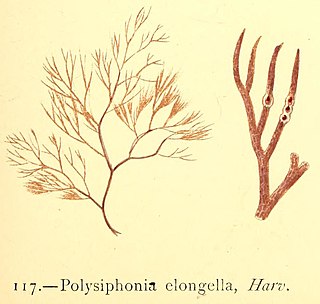
Polysiphonia elongella Harvey in W.J. Hooker is a branched species of marine red algae in the genus in the Polysiphonia in the Rhodophyta.
Polysiphonia fibrata is a species of Polysiphonia that grows as small dense tufted and finely branched marine alga in the Rhodophyta.

Polysiphonia fibrillosa (Dillwyn) Sprengel is a species of marine red alga in the Rhodophyta.

Melanothamnus harveyi, Harvey's siphon weed, is a small marine red alga in the division of Rhodophyta.
Vertebrata thuyoides is a small marine algae in the Division Rhodophyta.
Ceramium flaccidum is a small red marine alga in the Division Rhodophyta.
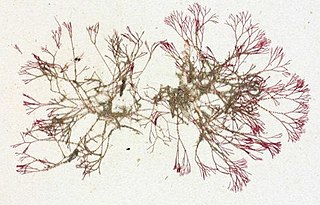
Ceramium cimbricum is a small red alga in the division Rhodophyta.
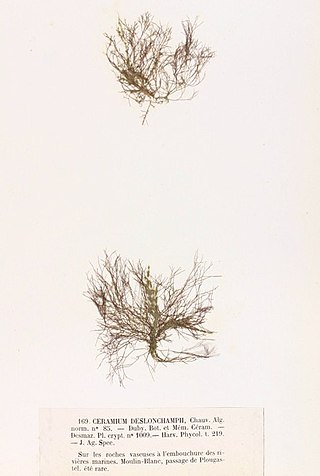
Ceramium deslongchampsii is a small marine red alga in the Division Rhodophyta.

Ceramium shuttleworthianum is a small marine red alga.
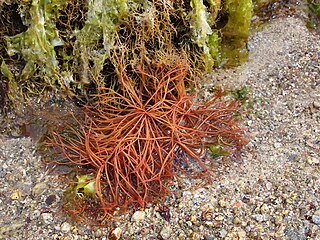
The Gracilariaceae is a small family of red algae containing several genera of agarophytes. It has a world-wide distribution. 24 species are found in China, and 6 species are found in Great Britain and Ireland. It is found in Australia and Chile.

Naccariaceae is a family of red algae in the order Bonnemaisoniales, with 3 monotypic genera that are found in both the Pacific and Atlantic Oceans.












